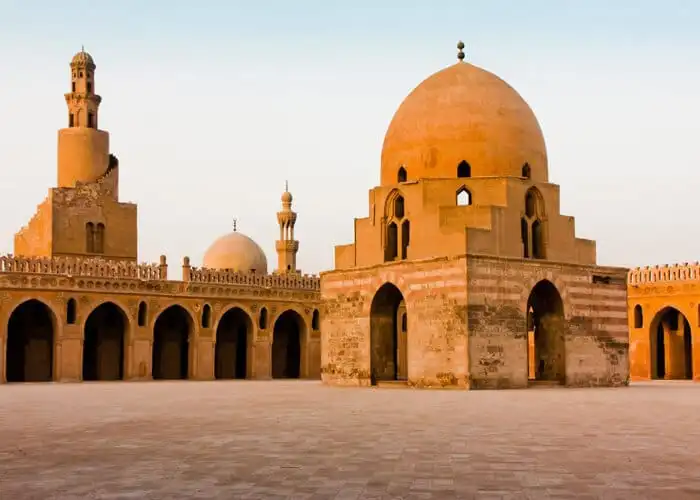The Ibn Tulun Mosque in Cairo stands as an awe-inspiring symbol of Egypt’s rich Islamic history and architectural innovation. It is the oldest surviving mosque in Cairo, renowned for its vast size, striking red brickwork, and the unique spiral minaret that dominates the skyline. As a living monument to the creativity and strength of the Tulunid dynasty, this mosque enchants visitors with its timeless grandeur and cultural significance stretching over a millennium.
Location: Nestled on Jabal Yashkur in Cairo
The mosque is prominently located on Jabal Yashkur (The Hill of Thanksgiving), an elevated site in the historic part of Cairo. This strategic placement not only gave it prominence in the city’s ancient landscape but also symbolizes gratitude and spiritual significance. Situated near Sayyida Zaynab district, the mosque remains a centerpiece in the vibrant modern city yet transports visitors into the depths of time and tradition.
History: Constructed under Ahmad ibn Tulun’s Vision
Commissioned by Ahmad ibn Tulun, the Abbasid governor who gained de facto independence over Egypt between 868 and 884 AD, the mosque was built between 876 and 879 AD. Ahmad ibn Tulun established his own capital, al-Qata’i, and this mosque served as its congregational heart. Despite the destruction of al-Qata’i in the 10th century by Abbasid forces, the mosque survived, making it the sole witness to the Tulunid capital’s legacy and a proud emblem of early Islamic Cairo.
Architectural Design
The mosque’s vast hypostyle courtyard spans over 6 acres, surrounded by arcades with red brick piers supporting the roof. Its design was inspired by the Great Mosque of Samarra in Iraq, especially the distinctive external spiral minaret, one of only a few in the world. The building features ‘arais’ – crenellations shaped like abstract human or doll forms – which embellish the façade. The extensive use of fired red brick, carved stucco decorations, pointed arches, and detailed motifs distinguishes Ibn Tulun as a masterpiece of Islamic architecture with an innovative spirit.
Sections of the Mosque
Ibn Tulun Mosque includes a large open courtyard with a central fountain dating back to the 13th century, while surrounding halls provide sheltered spaces for prayer and reflection. The mosque has over 20 entrances and combines grand communal areas with more intimate spaces designed for individual worship. A special doorway connects it to the once adjacent Tulunid palace, reflecting its original function as part of a larger complex.
What Makes Ibn Tulun Mosque Unique?
Its remarkable survival through centuries of urban change, wars, and reconstructions makes it extraordinary. The Ibn Tulun Mosque is one of the few remaining examples of early Abbasid architecture in Egypt, notable for its scale and originality. The spiral minaret, the large open courtyard, and its intricate decorations combine to create an architectural harmony rare in the region. As the oldest mosque in Cairo still in use, it remains a living testimony to Islamic spiritual and artistic heritage.
Fascinating Facts About Ibn Tulun Mosque
- The spiral minaret is inspired by the Great Mosque of Samarra but is unique for being external.
- It was designed by al-Nasrani, a Christian architect, reflecting cultural collaboration.
- The mosque’s red brick construction is unusual for Cairo, where stone was more common.
- It survived the destruction of the Tulunid capital and various earthquakes.
- Its architectural elements influenced later Islamic constructions across Egypt and beyond.
Conclusion
The Ibn Tulun Mosque is much more than a historical building; it is a living symbol of innovation, resilience, and spiritual devotion. Visiting this iconic site offers travelers the chance to walk through a millennium of history and experience the grandeur of one of Cairo’s most remarkable landmarks. It stands as a bridge connecting past and present, faith and art, making it an unforgettable destination for all.




